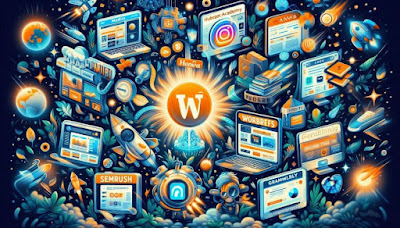Exploring the Future: How AI-Powered Google Maps is Revolutionizing Urban Navigation
In an era where technology continually reshapes our daily
lives, one of the most remarkable transformations is happening in the way we
navigate our cities. Google Maps, a tool many of us rely on for directions and
exploration, has undergone a significant evolution thanks to the integration of
artificial intelligence (AI). This blog post delves into how AI-powered Google
Maps is revolutionizing urban navigation, making it smarter, safer, and more
personalized than ever before.
AI Enhancements: The Brain Behind the Navigation
Google Maps has long been known for its reliable directions
and detailed maps. However, the advent of AI has taken these features to a new
level. Machine learning algorithms and real-time data processing are now at the
core of its functionalities. AI enhances Google Maps by:
- Analyzing Traffic Patterns: AI
algorithms predict traffic conditions based on historical data, current traffic
trends, and user-reported incidents. This means that the app can suggest the
fastest route by avoiding congested areas and adjusting in real-time if traffic
conditions change unexpectedly.
- Learning from User Behavior: Over
time, Google Maps learns from your navigation preferences and habits. If you
frequently visit certain types of locations, such as coffee shops or gyms, the
app can prioritize these types of suggestions in your future searches.
Smart Traffic Predictions: Navigating with Ease
One of the most practical applications of AI in Google Maps
is its ability to predict traffic conditions with remarkable accuracy.
AI-driven traffic predictions are based on a combination of historical data,
real-time traffic updates, and even weather conditions. This means you’re not
just given the fastest route at the moment; Google Maps can anticipate
potential delays and offer alternative routes before you even encounter the
traffic jam.
For instance, if there’s a major event causing increased traffic in a certain area, Google Maps will adjust your route accordingly, helping you avoid the congestion and saving you valuable time.
Personalized Recommendations: Your City, Your Way
AI's impact extends beyond just getting you from point A to point B. It also plays a crucial role in personalizing your urban experience. Google Maps uses AI to analyze your search history, previous visits, and even the types of places you like to frequent. This allows it to offer tailored recommendations that align with your interests.
Imagine you’re traveling to a new city. Instead of sifting
through countless reviews and listings, Google Maps can suggest popular
restaurants, hidden gems, or must-see attractions based on what it knows about
your preferences. This level of personalization enhances your travel experience
and helps you discover new places that you’re likely to enjoy.
Augmented Reality (AR) Integration: Navigating in the Real World
Augmented Reality (AR) is another exciting feature enhanced by AI in Google Maps. With AR integration, Google Maps provides a more intuitive navigation experience by overlaying directions and points of interest onto the real-world view from your smartphone camera.
When you’re walking through a new area, AR can guide you step-by-step, showing you precisely where to turn and highlighting nearby landmarks. This immersive experience not only makes navigation easier but also adds an element of fun to exploring new places.
Safety Features: Keeping You Informed
Safety is a top priority, and AI helps Google Maps enhance it by alerting users to potential hazards. AI algorithms analyze real-time data from various sources, including traffic reports and user feedback, to notify you about accidents, road closures, and construction zones.
For example, if there’s a road closure ahead due to an accident, Google Maps will alert you and suggest an alternative route, helping you avoid any delays or dangerous situations. This proactive approach to safety ensures that your journeys are not only more efficient but also safer.
Future Trends: What’s Next for AI in Navigation?
The future of AI in navigation is incredibly promising. As
technology continues to advance, we can expect even more sophisticated features
in Google Maps. Possible future trends include:
- Enhanced Predictive Analytics: More accurate predictions for travel time and traffic conditions, taking into account a broader range of factors.
- Voice-Activated Navigation:
Improved voice recognition capabilities allowing for more natural and
hands-free interaction.
- Seamless Integration with Other Apps: Better integration with other services and apps for a more cohesive user experience.
- Personalized Health and Fitness Routes: AI could help plan routes that align with your health and fitness goals, such as finding the best paths for running or cycling.
User Experiences: Real-Life Benefits
Many users have already experienced the benefits of AI-powered Google Maps. From avoiding traffic jams during a busy commute to discovering a new favorite café in a foreign city, the enhanced features have made navigation more efficient and enjoyable. Here are a few testimonials:
- Sarah J., Commuter:
“Google Maps’ real-time traffic predictions have saved me from countless
delays. It’s like having a personal traffic advisor in my pocket!”
- Mike L., Traveler: “The
personalized recommendations are fantastic. I found a local restaurant in Paris
that I wouldn’t have discovered without Google Maps!”
- Emily R., City Explorer: “The
AR navigation feature is a game-changer. It made exploring a new city so much
easier and more engaging.”
AI-powered Google Maps is transforming the way we navigate
our urban environments, making our travels more efficient, personalized, and
safe. As technology continues to evolve, we can look forward to even more
exciting innovations that will further enhance our navigation experiences.
Whether you’re commuting, traveling, or simply exploring your city, Google Maps
is set to remain an indispensable tool in your digital arsenal.
Stay tuned for more updates on how AI is reshaping the way
we live and explore our world!





















